RA Review
Review of the Royal Academy’s new exhibition, “Revolution, Russian Art 1917-1932”
This review originally appeared on the Birkbeck Department of English and Humanities staff blog (click here to view the original post).
One hundred years after the Russian Revolution of 1917, London’s Royal Academy is staging an exhibition of the idealistic early years of Russian avant-garde art, “Revolution, Russian Art 1917-1932” (11 February-17 April 2017). In presenting this 15-year slice of prolific revolutionary aesthetic activity, the RA is inspired by the State Russian Museum in Leningrad, which held an exhibition titled “Fifteen Years of Artists of the Russian Soviet Republic” from November 1932 until January 1933. It’s interesting to note that in the early 1930s the canonisation of those artists, photographers, filmmakers and writers involved in establishing the founding myths of the Soviet republic were already straining to differentiate themselves from the grim Socialist Realism that the Stalinist state approved as the only legitimate aesthetic style. And the RA’s exhibition is similarly concerned with rescuing the utopian potential of the revolution’s euphoric “heady days” as centuries of autocratic rule were swept away in a few short years and the creative arts experienced an electrifying renaissance.
The exhibition opens with the personality cults of Lenin and Stalin in the “Salute the Leader” room. Enormous oil paintings such as Isaak Brodsky’s Vladimir Lenin and a Demonstration (1919) and Lenin in Smolny (1930) remind us that not everyone in the revolutionary period was celebrating the avant-garde reconfiguration of form in geometric constructivist or abstract Suprematist experiments. Painters like Brodsky had been trained at the Imperial Academy of Arts in Saint Petersburg and had even formed a society of artists opposed to the avant-garde (the Association of Artists of Revolutionary Russia). Whilst a member of this association, Brodksy painted a number of portraits of Lenin and his photographic Realism is put to striking effect in Lenin in Smolny, with its palpable texture and forensic detail. It’s curious to think that towards the end of Lenin’s life, Stalin actually encouraged the personality cult of his political rival as it helped to shore up his own authoritarian leadership. Kuzma Petrov-Vodkin’s Beside Lenin’s Coffin (1924), which was banned from being exhibited for years, makes a rare appearance at the RA. As the co-curator Natalia Murray explains, although the public could visit his body, which has remained on public display in the Red Square since he died, Lenin’s embalmed corpse elevated him into the godlike status of an ancient Egyptian deity. Leninania maintains that the body must be kept in a state of readiness for its resurrection one day in a kind of proletkult Second Coming; whereas Petrov-Vodkin’s controversial painting (which is usually hidden away in storage at the State Tretyakov Gallery in Moscow) prominently displays his mortality. The sinister side of the Lenin cult is also brought home in an oddly tragi-comedic exhibit: the red and tan kerchief of Lenin by Nikolai Demkov (1924), in which Trotsky’s head has been carefully cut out of the handkerchief’s bottom left-hand corner; the excision leaving a gaping hole in the fabric.
Nikolai Demkov, Kerchief with Portrait of Lenin in the Centre and Trotsky’s Corner Portrait Cut Out (1924), Cotton, Exhibition catalogue, p. 67.
In the “Man and Machine” room we are treated to the expansive canvas of the early republic’s grand programme of mechanisation, engineering and electrification. This is the Russian revolutionary imaginary we are perhaps most familiar with – the new visual language of collaged propaganda posters and monochromatic lithographs; with their heroic workers, collective crowds and optimistic sloganeering. Set against the backdrop of heavy industry, we gaze upwards at towering construction and shock-workers – as in Arkady Shaiket’s gelatin silver prints Construction of the Moscow Telegraphic Centre (1928) and Komsomol at the Wheel (1929), with its glossy machinic definition – or marvel at the imposing musculature of Alexander Deineka’s barefoot Textile Workers (1927).
But it is Konstantin Yuon’s New Planet (1921) (chosen as the cover for the exhibition’s catalogue) that is breaktaking, and forcefully brings home the galactic scale of revolutionary ambition. Although the tempera painting is small (measuring just 71 by 100cm), the emulsion colours are absolutely stunning. I spent several minutes mesmerised in front of this painting and couldn’t help recalling the importance of the red planet to the revolutionary Russian imaginary. Early novels like Alexander Bogdanov’s Red Star (1908) and Leon Trotsky’s Aelita (1922) both stage the Russian Revolution on Mars, with technologically and culturally superior Martians helping to spread the dictatorship of the proletariat across the galaxy.
Konstantin Yuon, New Planet (1921), Tempera on cardboard, Exhibition catalogue, p. 115.
I have long been an admirer of Russian avant-garde filmmakers like Dziga Vertov and Sergei Eisenstein – both represented in the exhibition with projected clips of October: Ten Days That Shook the World (1928) and Man With a Movie Camera (1929) – as well as the austere photomontage propaganda posters of Solomon Telingater, Georgii Kibardin, Gustav Klutsis and Lazar “El” Lissitsky (many of which are collected in David King’s encyclopaedic Red Star Over Russia: A Visual History of the Soviet Union from 1917 to the Death of Stalin [2009]). But I hadn’t quite been prepared for the inclusion of landscape painting in an exhibition dedicated to revolutionary Russian art, such as Igor Grabo’s By the Lake (1926), Vasily Baksheev’s Blue Spring (1930), or Konstantin Yuon’s The Day of Anunciation (1922). Collected together in the “Eternal Russia” room, these works remind us of the persistence of religious devotion within an enduring peasant culture of “Old Russia” after the October Revolution.
Vasily Baksheev, Blue Spring (1930), Oil on wood, Exhibition catalogue, p. 222.
The sumptuous turquoise, azure and cerulean brushstrokes of Grabar’s and Baksheev’s skies, or the glinting cathedral spires in Yuon’s scene of winter sunshine and religious devotion, have an unlikely place amid the heroic workers and vast scenes of industrialisation; but arguably they occupy an imaginary that is every bit as insistently utopian. Blue, of course, was an intensely spiritual colour for Vasily Kandinsky in his theory of colour (as outlined in The Spiritual in Art [1912]), and was similarly the most utopian colour for the German philosopher Ernst Bloch, who ascribed to it the power of longing for better times to come. Given the significance of symbolism, the inclusion of Marc Chagall’s iconic Promenade (1917-18) in the “Eternal Russia” room establishes the exhibition’s persuasive case for the inclusivity of a variety of different kinds of dreaming. Chagall’s wife Bella floats above the artist in Promenade, tethered to earth only by the fragile bond of his hand holding hers, and the bottle-green geometric background village is contrasted with the dusty pink church that echoes her cerise dress, and reminds us of the ongoing significance of religious devotion in ordinary Russian life.
Indeed, one of the exhibition’s carefully wrought successes is its variety, which opens up the complex and competing strands of distinct avant-garde and revolutionary styles. In the “Brave New World” room, for instance, I was particularly struck by the freshness of Kandinsky’s use of colour and emotional intensity in oil paintings such as Troubled (1917) and Blue Crest (1917). Shortly after his Blaue Reiter Expressionist period, these canvases represent the effect that retuning to Russia to help run the Institute of Artistic Culture in Moscow had on Kandinsky’s middle period. Kandinsky’s figurative painting highlights the violent splits between aesthetic approaches at the time. In 1911 the Commissar for Enlightenment, Anatoly Lunacharsky, had described Kandinsky as a man “obviously in the final stage of psychic degeneration” and Malevich similarly poured vitriolic disgust on Kandinsky’s Expressionist spiritualism, describing the painter as “among the ranks of those whose rotting individualist aesthetics have been pushed to the point of solipsism.”[1]
One of the other notable surprises of the exhibition was the quality of textiles and ceramics, which are little seen outside of Russia. Vladimir Maslov’s Tractor (1925), for example, offers sumptuous ornamental chintz featuring great wreaths of blackberries, blueberries, raspberries and apples. This harvest bounty separates agricultural vignettes of labourers working horse-drawn ploughs as well as tractor-driven machinery in a curiously romanticised vision of collectivised farms that blends kitsch pastoralism with electrification and industrialisation.
Vladimir Maslov, Tractor (1925), Ornamental chintz, cotton fabric, Exhibition catalogue, p. 203.
Similarly, Ivan Ivanovich Piznich’s Large Vase with Peasant Dance (1929) is exquisite in its hand-painted detail (the catalogue photo really doesn’t do it justice). The use of vitrified enamel paint on a porcelain vase renders with impeccable detail the village dance of peasants accompanied by an accordion player, with excitable barking dogs nipping at their heels. Meanwhile, Nikolai Suetin’s supremacist-decorated plates and coffee pots are more the sort of thing we imagine when we consider the nationalisation of ceramics production after the Bolsheviks had seized the Imperial Porcelain Factory in Saint Petersburg. Why waste all that fine porcelain and bisque when you can simply repurpose it with commemorative pictures of textiles factories and energetic workers?
In “The Fate of the Peasants” we are brought forcefully back to the reality of Stalin’s collective farms and the poverty and famine during the food shortages of the early USSR period. Nikolai Suetin’s A Woman with a Sow (c. 1920) and Malevich’s Head of a Peasant (1928-9) barely individuate singular figures among the sharply contrasted blues, greens and blacks of their agricultural backdrop. Meanwhile, Konstantin Rozhdestvensky’s lurid, flat landscape in Family in a Field (1932) imposes itself upon the viewer, demanding attention. With its oily green, yellow and tangerine horizontal stripes of colour and sense of empty despair, the painting feels quite overwhelming and nauseating, as if these shimmering figures are watching the impending apocalypse in some garish yellow nuclear holocaust or approaching gas cloud.
Konstantin Rozhdestvensky, Family in a Field (1932), Oil on cardboard, Exhibition catalogue, p. 190.
Kazimir Malevich’s faceless peasants are also prominently featured, with works such as Peasants (c. 1930) and Woman with Rake (1930-2) emphasising the terrifying anonymity of these collective workers. The exhibition ends with “Stalin’s Utopia” and the emergence of Socialist Realism. Among this room’s daunting celebration of athleticism, military parades and devoted Soviet sportsmen and women, a couple of pieces stood out for me. Alexander Deineka’s Football (1924), for example, offers a striking example of the use of abstraction in early Soviet Realist style before Stalinist authoritarianism ossified the form in a backlash against experimentation. Described as “expressionist urbanism,” Deineka’s painting gives us the austere graphic musculature of bare-chested players required of Socialist Realism’s heroic athleticism; but the players are silhouetted against a pallid grey background, with only a wedge of colour and landscape appearing in the painting’s top centre, connecting this work more with the strategies of abstraction employed by Russia’s “left” artists than Deineka’s later work allows, as well as echoing the figurative use of colour by Kandinsky or Aristarkh Lentulov.
For me, the standout work of the enture exhibition was Kuzma Petrov-Vodkin’s symbolist painting Fantasy (1925). A young proletarian is seated bareback on a magnificent red horse that flies across the Russian countryside like Chagall’s wife Bella.
Kuzma Petrov-Vodkin, Fantasy (1925), Oil on canvas, Exhibition catalogue, p. 285.
The horse is moving in the direction of progress, its Great Leap Forward bounding effortlessly across the blue haze of the rural landscape. But the rider looks backward, his gaze fixed on something beyond the frame of the painting, that we cannot see. Like Paul Klee’s distinctive Angelus Novus (1920) – immortalised by Walter Benjamin’s suggestion that it represents the progress of historical time – the rider moves forwards whilst facing Russia’s past. As Benjamin wrote in the “Theses on the Philosophy of History”: “Where we perceive a chain of events, he sees one single catastrophe which keeps piling wreckage upon wreckage and hurls it in front of his feet.” I’ve always felt that the insight of Benjamin’s Thesis IX wasn’t particularly suited to Klee’s painting, which, after all, resembles a cartoon chicken. But I think the sentiment is perhaps better suited to Petrov-Vodkin’s young rider in Fantasy. The success of the RA’s exhibition is to show us the utopian seriousness and sense of tangible possibility at work in the various artistic avant-gardes and revolutionary artists working in Russia after the October Revolution. But, of course, the prescience of Petrov-Vodkin’s Fantasy lies in the fact that the backward-facing rider simultaneously anticipates the brutal massacres to come in Stalin’s Russia, the chilling next chapter in Russian history.
Note:
[1] Royal Academy of Arts, Revolution: Russian Art, 1917-1932 (Exhibition catalogue) (London: Royal Academy of Arts, 2017), pp. 24, 17.

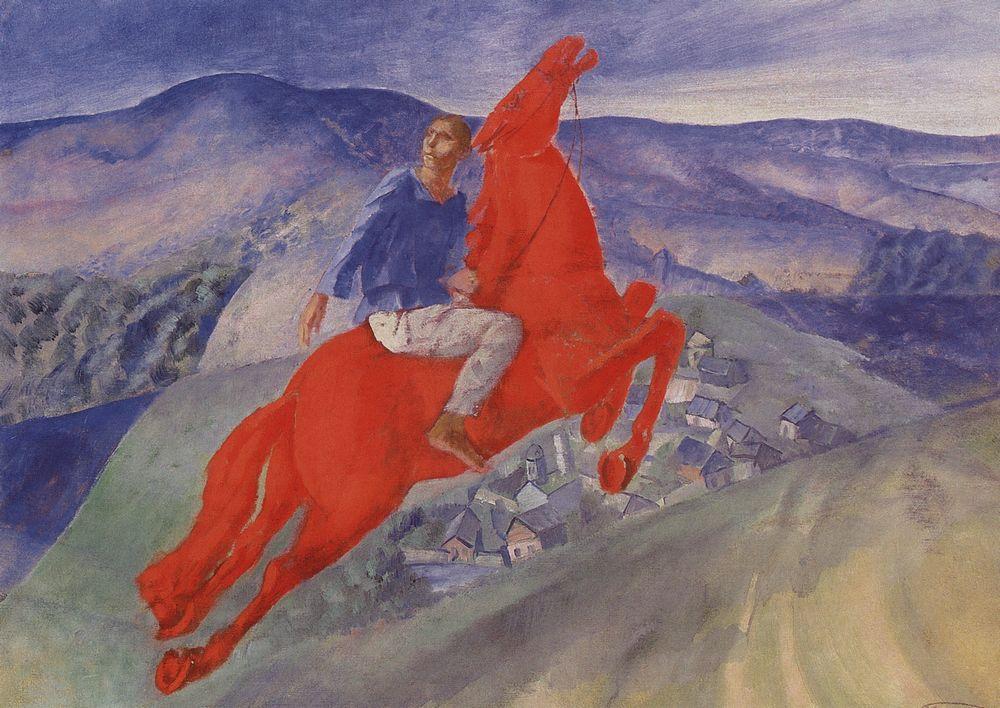





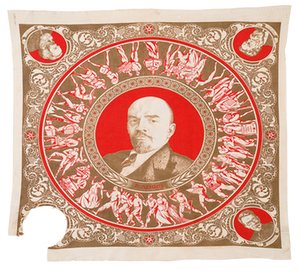
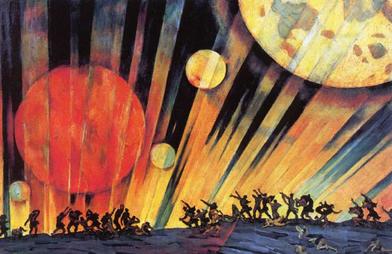
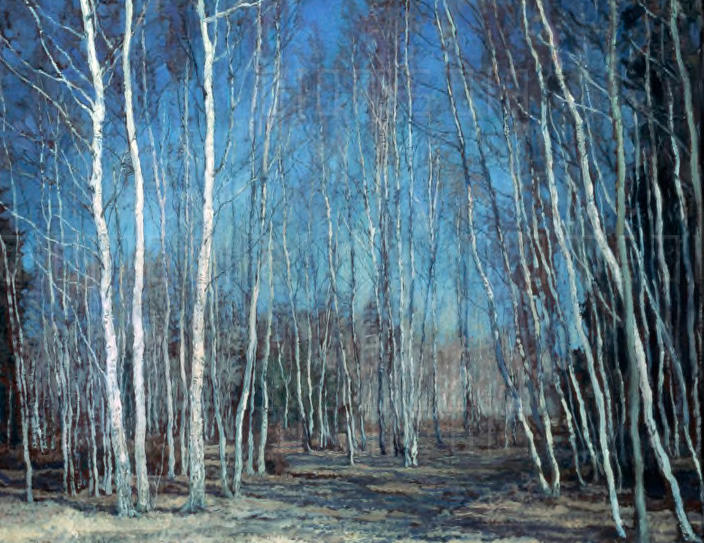
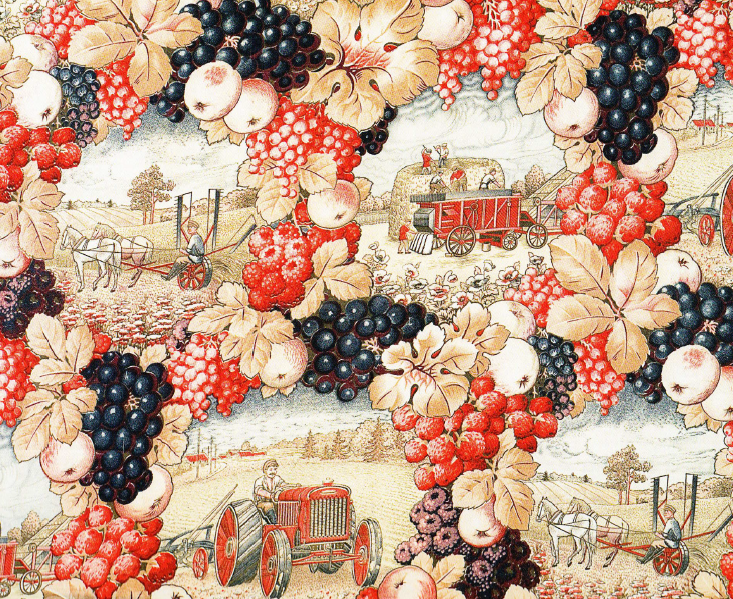
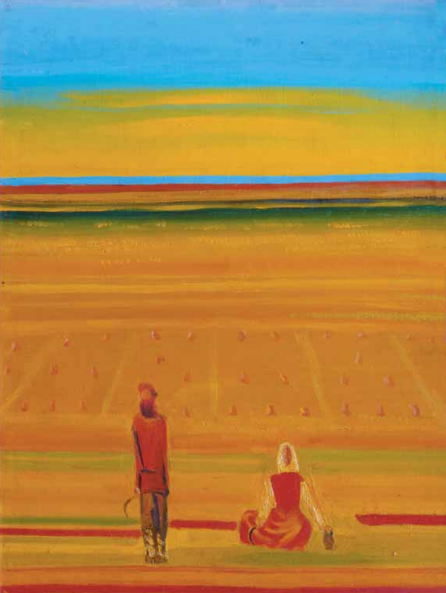
 Dr Caroline Edwards is Senior Lecturer in Modern & Contemporary Literature at Birkbeck, University of London. Her research and teaching specialisms are in 21st century literature and critical theory, science fiction and post-apocalyptic narratives, Marxist aesthetics, and utopianism.
Dr Caroline Edwards is Senior Lecturer in Modern & Contemporary Literature at Birkbeck, University of London. Her research and teaching specialisms are in 21st century literature and critical theory, science fiction and post-apocalyptic narratives, Marxist aesthetics, and utopianism.
I was interested to read your review you featured Konstantin Yuon, New Planet and Konstantin Rozhdestvensky, Family (?!!) in a Field.
Astonishing images.
To which I’d add Alexander Samokhvalo’s Tram Conductor, 1928.
Amazing show.
Bit like Russian music. It absorbs something from the West but is strikingly imaginative.